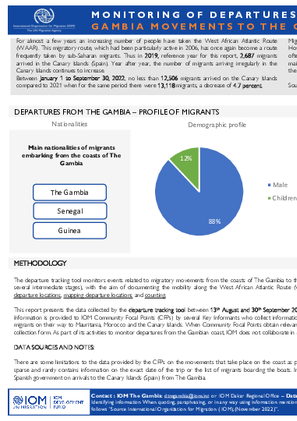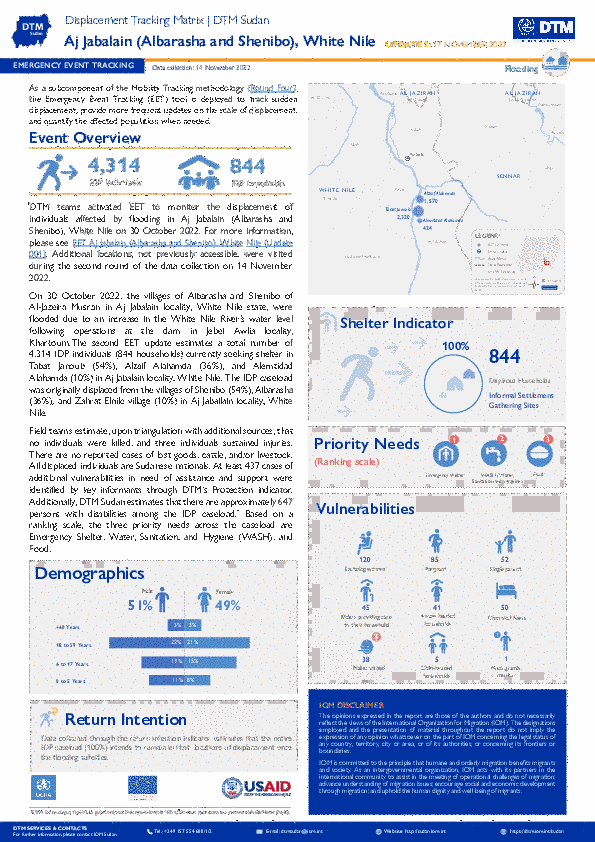-
Countries
-
Data and Analysis
-
Special Focus
-
Crisis Responses
Contact
Location
Lebanon
Activity
- Flow Monitoring
- Migrants presence
- Baseline Assessment
Period Covered
Oct 01 2020 -Jun 30 2021
The MPM baseline assessment is designed to systematically assess, through a series of MPM Rounds, cadastres (Admin 3 areas) in Lebanon to quantify the presence of migrants per this administrative area to support operational assistance, coordination, and planning. The data collection is based on estimations received from Key Informants (KI) who are mostly composed of Mukhtars, local authorities of these areas, and Municipality officials. The MPM relies on KIs to provide reliable information for a specific and known area. For data collection, the administrative area of a cadastre was chosen as it is the smallest administrative unit with dedicated administrative officers, and the areas are small enough to ensure that information collected on the area are reliable. As a result of the situation and arrangements of migrant populations, repeated rounds will strengthen the data collected and resultant baseline.
An assessment was conducted on a total of 1,610 cadastres spanning 26 districts and 8 governorates in Lebanon, which covers approximately 98.96% of all cadastres in the country. During the initial data collection phase, it was estimated that 207,696 migrants were identified within these 1,610 cadastres across the 26 districts, again representing a coverage of approximately 98.96% of all cadastres in Lebanon.
Furthermore, between October 2020 and June 2021, a total of 3,857 key informants were interviewed.
Population Groups
Survey Methodology
Unit of Analysis Or Observation
Type of Survey or Assessment
Keywords
Geographical Scope
Administrative boundaries with available data
The current dataset covers the following administrative boundaries

Contact
DTM Uganda, dtmuganda@iom.int
Language
English
Location
Uganda
Period Covered
Oct 01 2022
Oct 31 2022
Activity
- Survey
- Flow Monitoring
In October 2022, a total of 2,222 people were interviewed at four Flow Monitoring Points (FMPs) across the border between Uganda and Kenya. Similar to the previous period, more people interviewed were incoming to Uganda (55%) than outgoing to Kenya (45%). Potential indicators of protection risks observed among people surveyed included travelers with no accommodation arranged at their destination (67%) followed by travelers required to repay expenses of journey (21%), migrants with no identification document (20%), traveler with job offer lined up at destination (15%) and traveler required to repay recruitment fees (<1%). Information sources about cross-border job offers were mostly friends, relatives or community in either departure or destination (68%).

Contact
DTMMozambique@iom.int
Language
English
Location
Mozambique
Period Covered
Nov 09 2022
Nov 15 2022
Activity
- Mobility Tracking
- Event Tracking
Fear of attacks and confirmed attacks by Non-State Armed Groups in Namuno district from 9 November triggered 12,535 individual displacement movements within and between neighbouring districts of Namuno. DTM monitoring teams recorded at least 7 major travel routes taken by populations on the move between 09-15 November. This includes movements within Namuno (5,010 individuals), within Montepuez (773 individuals), movements from Namuno to Montepuez (1,264 individuals), movements from Balama to Montepuez (3,352 individuals), movements within Balama (2,062 individuals) and movements from Namuno to Balama (56 individuals), and as well as intended return movements from Montepuez to Balama (18 individuals). An estimate of 848 Internally Displaced Persons (IDPs) have been identified with vulnerabilities. Of the 12,535 individual displacement movements recorded, an estimate 6,384 Individuals (of which 3,517 represent children under 18 years old) walked to their current locations of displacement. Within this reporting period, 86 per cent of the recorded movements represent individuals displaced for
the first time and 14 per cent for the second time.
IOM teams observed an average of 1,791 individuals arriving at different locations within the reporting period (09 - 15 November, please see below for more information). Movements in the region continue to be dynamic between host communities. Cumulatively, from the first attacks in Namuno on 29 October till date, an estimated 27,244 first-time individual displacements have been observed by DTM monitoring teams. The objective of the Emergency Tracking Tool (ETT) - Movement Alert is to collect information on large and sudden population movements, and to provide support to the humanitarian response partners by disseminating data on IDPs to support effective humanitarian response to the affected population. Information is collected through key informants interviews or direct observation. This dashboard provides basic information on displacements, and additional information can be shared upon request.

Contact
DTMMozambique@iom.int
Language
English
Location
Mozambique
Period Covered
Nov 14 2022
Nov 15 2022
Activity
- Mobility Tracking
- Event Tracking
Fear of attacks and confirmed attacks by Non-State Armed Groups in Namuno district triggered 1,092 individual displacement movements from Namuno to Nipepe Sede (Niassa). All recorded movements represent individuals displaced for the first time.
Observed families arriving in Nipepe are hosted by relatives or friends within the locality. All arriving families do not know how long they intend to stay in Nipepe. Movements in the region continue to be dynamic between host communities.
The objective of the Emergency Tracking Tool (ETT) - Movement Alert is to collect information on large and sudden population movements, and to provide support to the humanitarian response partners by disseminating data on IDPs to support effective humanitarian response to the affected population. Information is collected through key informants interviews or direct observation. This dashboard provides basic information on displacements, and additional information can be shared upon request.

Contact
dtmgambia@iom.int rodakar dataresearch@iom.int
Language
English
Location
The Gambia
Period Covered
Aug 01 2022
Sep 30 2022
Activity
- Other
- Flow Monitoring Survey
For almost a few years an increasing number of people have taken the West African Atlantic Route (WAAR). This migratory route, which had been particularly active in 2006, has once again become a route frequently taken by sub-Saharan migrants. Thus in 2019, reference year for this report, 2,687 migrants arrived in the Canary Islands (Spain). Year after year, the number of migrants arriving irregularly in the Canary Islands continues to increase. Between January 1 to September 30, 2022, no less than 12,506 migrants arrived on the Canary Islands compared to 2021 when for the same period there were 13,118 migrants, a decrease of 4.7 percent. Migrants generally leave the coasts of Morocco or Mauritania which are closer to the Canary Islands. However, departures are often prepared from the coasts of Gambia and the trip to the Canary Islands often includes several intermediate stages. Since August 2022, IOM The Gambia has been monitoring the main departure points for boats bound for the Canary Islands. This report presents the main data collected, the methodology used, and the other events identified by the investigators along the Gambian coast.

Contact
DTM Uganda, dtmuganda@iom.int
Language
English
Location
Uganda
Period Covered
Oct 01 2022
Oct 31 2022
Activity
- Mobility Tracking
On 20th September 2022, the Ministry of Health declared an outbreak of the Sudan strain on Ebola virus disease (EVD) after a case managed at Mubende Regional Referral Hospital (MRRH) in Mubende district was confirmed through testing at the Uganda Virus Research Institute (UVRI). Other cases were confirmed in Kyegegwa, Kasanda, Bunyangabu, Kagadi, Kampala, Jinja, Masaka and Wakiso districts. And as per the reporting date, 140 cases have been confirmed with 55 deaths. Other hazards reported include “fires” and “heavy storms/hailstorms”. o A total of 201 individuals were affected by EVD, fires and heavy storms/hailstorms, displacing 24 individuals. o Adults (19-64) were the most affected population group (58%), followed by children under 18 (33%) and the elderly above 64 (9%). o The most pressing needs are health, hygiene promotion, water supply, shelter and food assistance. o So far in 2022, 118,139 individuals have been affected by disasters, representing 23,361 households. A total of 20,783 individuals representing 5,398 households have been internally displaced.
Contact
DTM Niger, NigerDataResearch@iom.int
Location
Niger
Activity
- Mobility Tracking
- Village Assessment
Period Covered
Apr 11 2022 -May 03 2022
A village assessment survey (VAS) is a sub-component of mobility tracking. It collects data on returning IDPs, IDPs, returned migrants and host community members. VAS evaluates the absorption capacity of villages to receive returning IDPs with a focus on accessibility of services, livelihoods and reintegration.
Population Groups
Survey Methodology
Unit of Analysis Or Observation
Type of Survey or Assessment
Keywords
Geographical Scope
Administrative boundaries with available data
The current dataset covers the following administrative boundaries
Contact
DTM Niger, NigerDataResearch@iom.int
Location
Niger
Activity
- Mobility Tracking
- Village Assessment
Period Covered
Jul 14 2022 -Aug 30 2022
A village assessment survey (VAS) is a sub-component of mobility tracking. It collects data on returning IDPs, IDPs, returned migrants and host community members. VAS evaluates the absorption capacity of villages to receive returning IDPs with a focus on accessibility of services, livelihoods and reintegration.
Population Groups
Survey Methodology
Unit of Analysis Or Observation
Type of Survey or Assessment
Keywords
Geographical Scope
Administrative boundaries with available data
The current dataset covers the following administrative boundaries

Contact
DTM Burkina Faso, BFInformationUnit@iom.int
Language
French
Location
Burkina Faso
Period Covered
Jul 01 2022
Sep 30 2022
Activity
- Survey
- Flow Monitoring Survey
- Flow Monitoring
Le suivi des flux de populations récolte des données sur les flux et tendances migratoires, les profils des voyageurs et les parcours et intentions des migrants, afin de fournir une meilleure compréhension des mobilités en Afrique de l’Ouest et du Centre.
Au Burkina Faso, la DTM recueille des données au niveau de 4 Points de suivi des flux (Flow Monitoring Points, FMP) que sont Dori/Seytenga, Kantchari, Faramana et Yendéré répartis dans 4 régions afin d’obtenir une meilleure compréhension de l’ampleur, des tendances, des caractéristiques socio-démographiques et des parcours des flux de voyageurs traversant ces différents points.
Ce rapport présente les données recueillies dans le cadre des activités d’enregistrement des flux et d’enquêtes individuelles durant le troisième trimestre de l’année 2022

Contact
DTM Sudan; dtmsudan@iom.int
Language
English
Location
Sudan
Snapshot Date
Nov 14 2022
Activity
- Mobility Tracking
- Event Tracking
The DTM Emergency Event Tracking (EET) is deployed to track sudden displacement and population movements, provide more frequent updates on the scale of displacement, and quantify the affected population when needed. As a subcomponent of the new Mobility Tracking methodology in Sudan (Round Four), and activated on a need basis, EET utilises a broad network of key informants to capture best estimates of the affected population presence per location – a useful tool for humanitarian response planning and design.